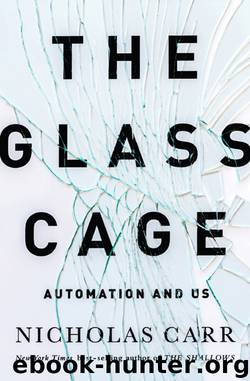The Glass Cage by Nicholas Carr

Author:Nicholas Carr
Language: eng
Format: epub
Publisher: W. W. Norton & Company
ARCHITECTS HAVE always thought of themselves as artists, and before the coming of CAD the wellspring of their art was the drawing. A freehand sketch is similar to a computer rendering in that it serves an obvious communication function. It provides an architect with a compelling visual medium for sharing a design idea with a client or a colleague. But the act of drawing is not just a way of expressing thought; it’s a way of thinking. “I haven’t got an imagination that can tell me what I’ve got without drawing it,” says the modernist architect Richard MacCormac. “I use drawing as a process of criticism and discovery.”37 Sketching provides a bodily conduit between the abstract and the tangible. “Drawings are not just end products: they are part of the thought process of architectural design,” explains Michael Graves, the celebrated architect and product designer. “Drawings express the interaction of our minds, eyes and hands.”38 The philosopher Donald Schön may have put it best when he wrote that an architect holds a “reflective conversation” with his drawings, a conversation that is also, through its physicality, a dialogue with the actual materials of construction.39 Through the back-and-forth, the give-and-take between hand and eye and mind, an idea takes form, a creative spark begins its slow migration from the imagination into the world.
Veteran architects’ intuitive sense of the centrality of sketching to creative thinking is supported by studies of drawing’s cognitive underpinnings and effects. Sketches on paper serve to expand the capacity of working memory, allowing an architect to keep in mind many different design options and variations. At the same time, the physical act of drawing, by demanding strong visual focus and deliberate muscle movements, aids in the forming of long-term memories. It helps the architect recall earlier sketches, and the ideas behind them, as he tries out new possibilities. “When I draw something, I remember it,” explains Graves. “The drawing is a reminder of the idea that caused me to record it in the first place.” 40 Drawing also allows the architect to shift quickly between different levels of detail and different degrees of abstraction, viewing a design from many angles simultaneously and weighing the implications of changes in details for the overall structure. Through drawing, writes the British design scholar Nigel Cross in his book Designerly Ways of Knowing, an architect not only progresses toward a final design but also hashes out the nature of the problem he’s trying to solve: “We have seen that sketches incorporate not only drawings of tentative solution concepts but also numbers, symbols and texts, as the designer relates what he knows of the design problem to what is emerging as a solution. Sketching enables exploration of the problem space and the solution space to proceed together.” In the hands of a talented architect, a sketchpad becomes, Cross concludes, “a kind of intelligence amplifier.” 41
Drawing might best be thought of as manual thinking. It is as much tactile as cerebral, as dependent on the hand as on the brain.
Download
This site does not store any files on its server. We only index and link to content provided by other sites. Please contact the content providers to delete copyright contents if any and email us, we'll remove relevant links or contents immediately.
Whiskies Galore by Ian Buxton(40623)
Introduction to Aircraft Design (Cambridge Aerospace Series) by John P. Fielding(32367)
Small Unmanned Fixed-wing Aircraft Design by Andrew J. Keane Andras Sobester James P. Scanlan & András Sóbester & James P. Scanlan(32155)
Craft Beer for the Homebrewer by Michael Agnew(17472)
Turbulence by E. J. Noyes(7078)
The Complete Stick Figure Physics Tutorials by Allen Sarah(6657)
Kaplan MCAT General Chemistry Review by Kaplan(6083)
The Thirst by Nesbo Jo(5815)
Bad Blood by John Carreyrou(5798)
Learning SQL by Alan Beaulieu(5445)
Weapons of Math Destruction by Cathy O'Neil(5068)
Man-made Catastrophes and Risk Information Concealment by Dmitry Chernov & Didier Sornette(4773)
iGen by Jean M. Twenge(4714)
Digital Minimalism by Cal Newport;(4605)
Life 3.0: Being Human in the Age of Artificial Intelligence by Tegmark Max(4534)
Audition by Ryu Murakami(4122)
Electronic Devices & Circuits by Jacob Millman & Christos C. Halkias(4061)
1,001 ASVAB Practice Questions For Dummies by Powers Rod(4055)
Pale Blue Dot by Carl Sagan(4031)
